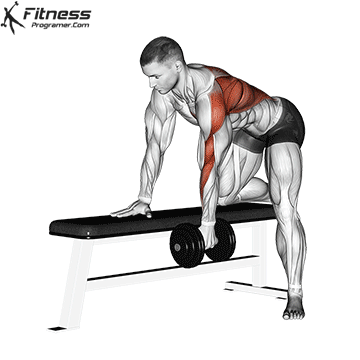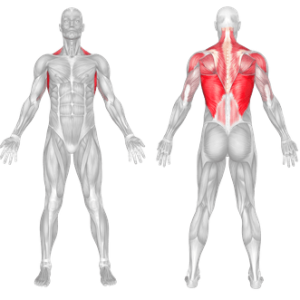Overview
The dumbbell row is a fundamental strength training movement that builds back thickness, improves posture, and enhances upper body pulling strength. This unilateral exercise allows for greater range of motion and muscle activation while correcting strength imbalances.
How to do Perform Dumbbell Row

Place your left knee and left hand on a bench, keeping your back flat and torso parallel to the ground.
Hold a dumbbell in your right hand, arm fully extended toward the floor, palm facing in.
Engage your core and pull the dumbbell up, driving your elbow toward your hip.
Pause at the top, squeezing your shoulder blade toward your spine.
Lower the dumbbell slowly to the starting position under control.
Complete reps, then switch sides.
Tips for Proper Form
Keep your back flat and avoid rounding or arching.
Lead with the elbow, not the hand.
Keep your shoulders square and avoid torso rotation.
Exhale as you row up, inhale as you lower.
Use controlled tempo, avoid jerking or rushing the movement.
Common Mistakes
Rounding the back, which strains the spine.
Using momentum to lift the weight.
Twisting the torso, which reduces lat activation.
Letting the shoulder drop at the bottom.
Shrugging the shoulder, engaging traps instead of lats.
Benefits of the Dumbbell Row
Strengthens the Upper and Mid Back: Targets the lats, rhomboids, and traps to build a stronger, wider back.
Improves Posture: Corrects forward shoulder posture by strengthening postural muscles.
Enhances Pulling Power: Transfers to improved performance in pull-ups, deadlifts, and rows.
Unilateral Muscle Balance: Helps address muscular imbalances between sides of the back.
Activates the Core: Stabilizes the trunk during the row, improving core strength.
Scalable and Versatile: Can be modified for strength, hypertrophy, or endurance goals.
Low Equipment Requirement: Needs only a dumbbell and a bench, making it accessible at home or gym.
How to Incorporate Into Your Routine
- For Beginners: Start with 2–3 sets of 8–10 reps per side using light weights and controlled form.
- For Hypertrophy: Perform 3–4 sets of 10–12 reps, focusing on slow negatives and lat squeeze.
- For Strength: Use 4–5 sets of 5–8 reps with heavier dumbbells and proper bracing.
- For Functional Training: Pair with lunges or planks in a unilateral strength circuit.
- For Circuit Training: Add 10 reps per arm into full-body circuits for upper body engagement.
- For General Fitness: Include in push-pull splits or full-body routines twice per week.
Dumbbell Row Muscles Worked

Frequently Asked Questions
Can beginners do dumbbell rows?
Yes, just start light and focus on proper form and back engagement.
Should I row to my chest or waist?
Row toward your waist or hip to better target the lats and avoid shoulder dominance.
How heavy should I go?
Use a weight that challenges you without compromising form. Prioritize control.
Is this better than barbell rows?
Both have benefits. Dumbbell rows offer unilateral focus and reduce spinal load.
Can I do them standing without a bench?
Yes, in a split stance bent-over position, as long as your back stays flat and stable.
